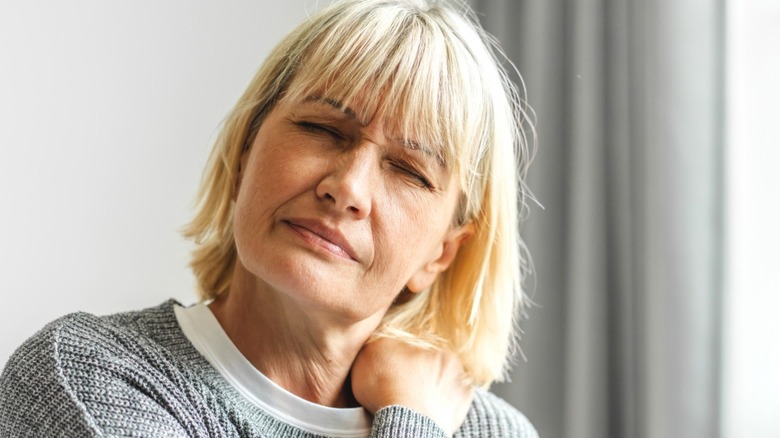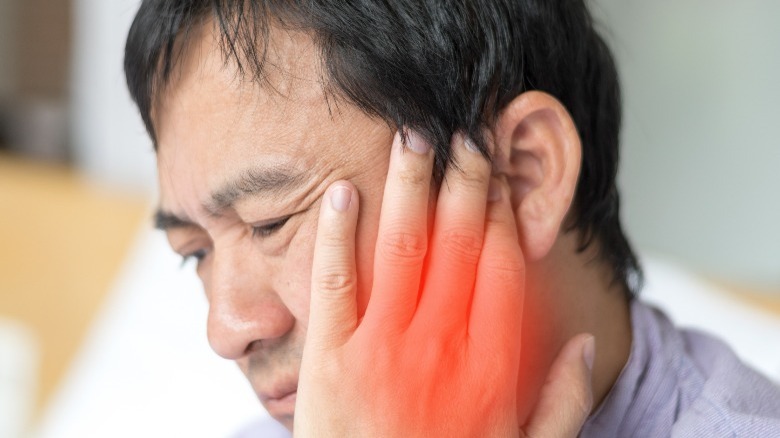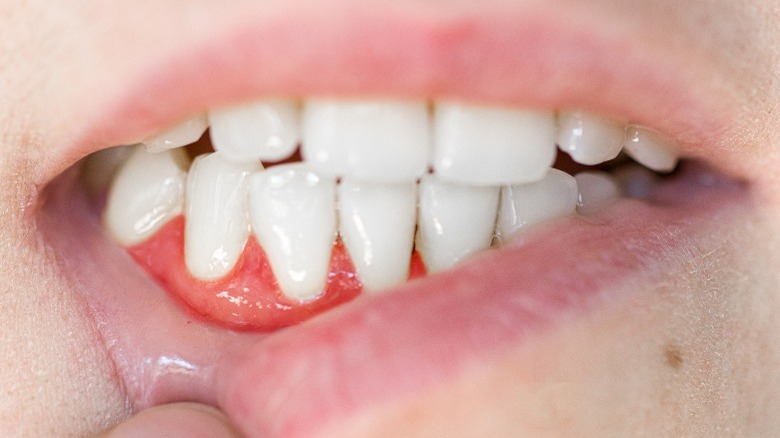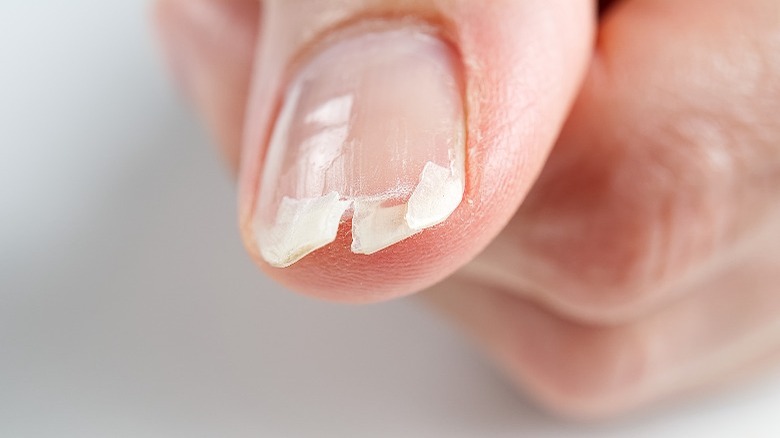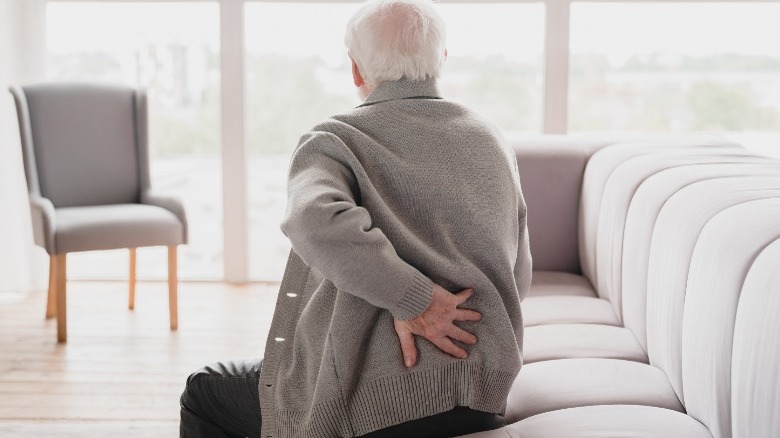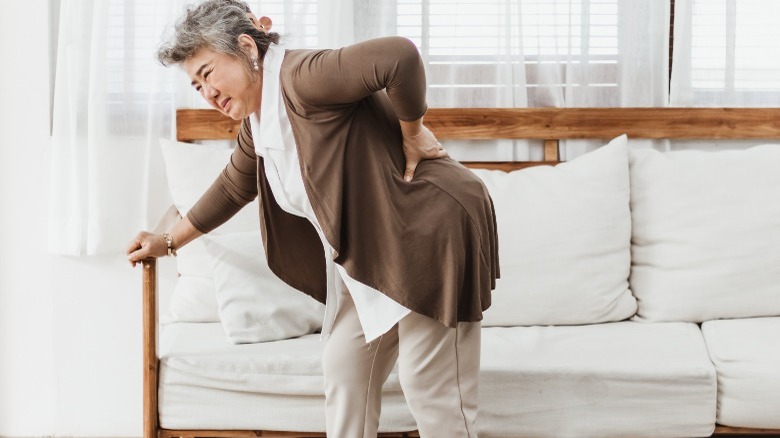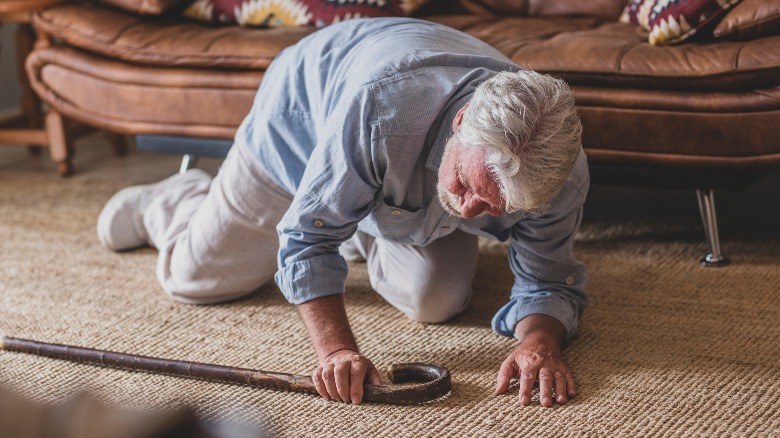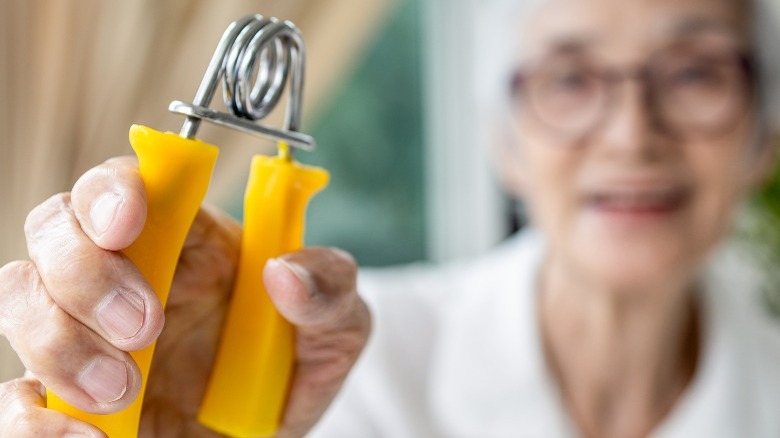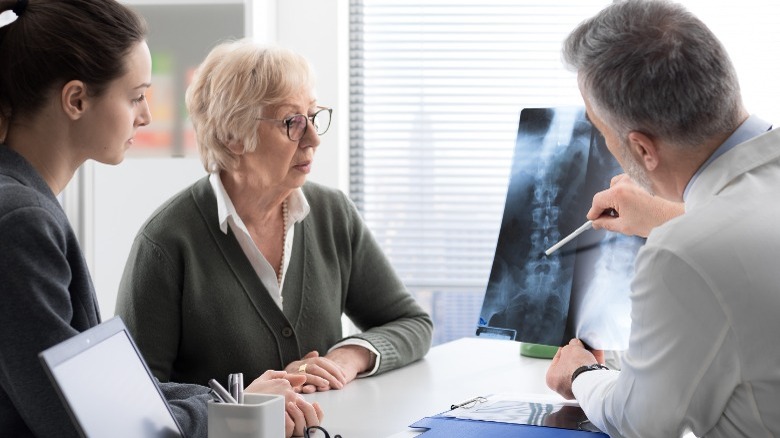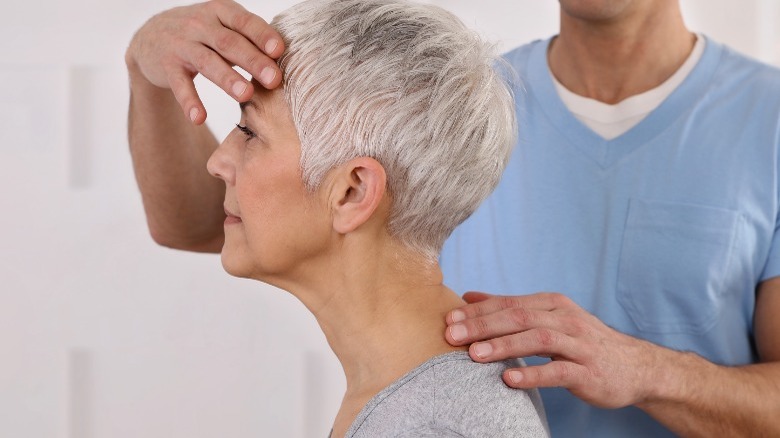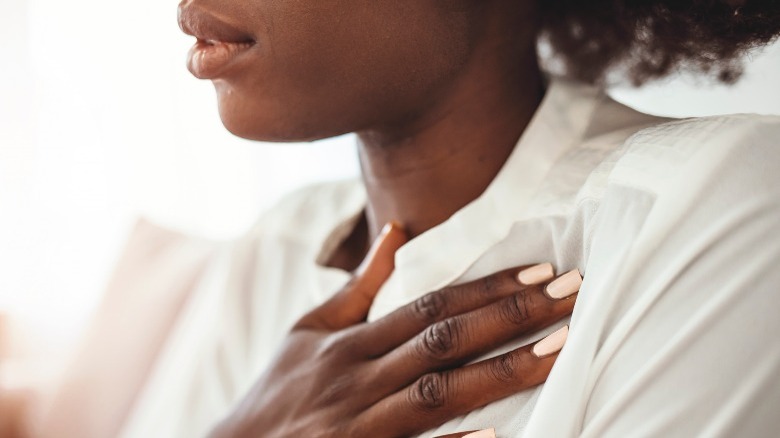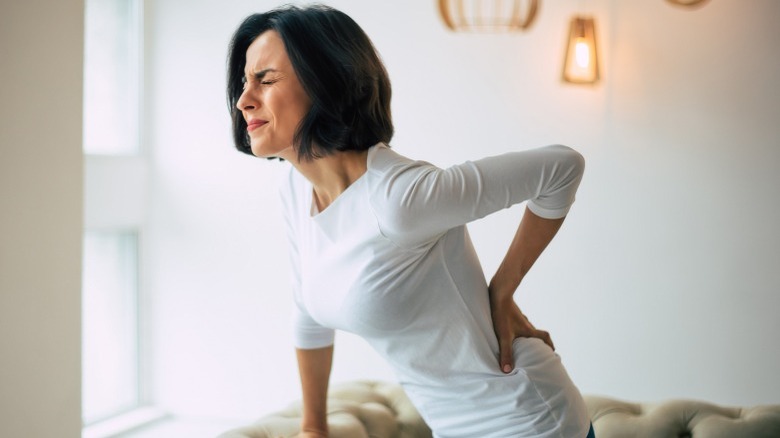Warning Signs Of Osteoporosis You Should Never Ignore
As we age, our bodies undergo changes that can increase the risk of certain health issues. One of those conditions is osteoporosis — a type of bone disease that affects about 10 million people in the United States alone (via the National Osteoporosis Foundation). The disease is characterized by low bone density and a decline in the ability to rebuild bone as quickly as you lose it. As the condition progresses, the bones become weaker and more susceptible to fractures (per MedlinePlus).
Those with the highest risk of developing osteoporosis are adult women over 50. However, one in four men aged 50 or older is expected to break a bone due to osteoporosis (per the National Osteoporosis Foundation). Osteoporosis is referred to as a "silent disease" because many people don't realize they have it until they actually break a bone. However, paying attention to warning signs can help you catch osteoporosis earlier and manage the symptoms to potentially avoid injuries and irreversible bone damage. Here are some signs that may indicate a loss of bone density resulting from osteoporosis.
Jaw joint issues
Although many people may associate osteoporosis with hip and wrist fractures, the disease can affect other bones and joints in the body (per WebMD). Osteoporosis causes bones to become more fragile and shrink over time, which also impacts the supportive bone structures in the mouth and jaw.
A recent study featured in the Journal of Oral and Maxillofacial Pathology noted that people with osteoporosis often experience issues with the temporomandibular joints (TMJ) and may have limited jaw functionality, including locked jaw and clicking, pain, tenderness, and stiffness of the jaw.
While jaw pain and other jaw joint issues can have many causes that are not necessarily a significant cause for concern, those with a higher risk of developing osteoporosis who are experiencing TMJ issues should contact their dentist or healthcare professional — especially if they have no prior history of jaw problems. It's worth getting to the bottom of the issue and ruling out low bone density if possible. If you find that you have low bone mineral density, you can work with your doctor to manage the effects of bone loss and prevent osteoporosis.
Receding gums
Although a receding gumline might not seem as if it could be related to osteoporosis, it could be a red flag signifying the presence of low bone density. According to a research review published in the Journal of Dentistry of Tehran University of Medical Sciences, there appears to be a relationship between osteoporosis and the occurrence of periodontal disease, which is an advanced form of gum disease that can potentially spread to the tissue beneath the teeth, including the jaw bone, according to the Centers for Disease Control and Prevention (CDC).
According to an article in Current Osteoporosis Reports, as the jaw bone starts to deteriorate and lose density from osteoporosis, individuals may experience tooth loss and deeper periodontal pockets, which is space created between a tooth and the gumline where bacteria can grow. Receding gums are a common sign of periodontal disease (via CDC). And given the evidence of a correlation between gum health and osteoporosis, identifying receding gums and discussing a possible connection to your bone health with a healthcare professional is vital.
Brittle nails
As hormones begin to fluctuate and wane during menopause, many women experience changes to their fingernails and toenails. According to Medical News Today, nails often become brittle and tend to break, split, and crack during this time. While weakened nails are a common occurrence as men and women age, a consistent drop in estrogen can also be linked to a loss of bone density and an increased likelihood of developing osteoporosis (via the Journal of Functional Biomaterials).
Estrogen plays an essential role in women's sexual development and reproductive health (per Cleveland Clinic). However, menopause is a natural transition process that involves a drop in estrogen levels when women reach the end of their fertile years. If you notice your nails are not as strong as they used to be, it could be a sign that your estrogen levels are changing. Along with those changes comes an increased risk of bone density loss and osteoporosis, according to the Journal of Functional Biomaterials.
If you find that your brittle nails indicate a drop in estrogen levels, your doctor can share tips and recommendations on managing the effects of low estrogen and preventing bone mass loss as you age.
Frequent compression fractures
One of the more obvious signs that your bone health is declining is frequent breaks and fractures (via The Ohio State University Wexner Medical Center). Activities that were once easy or routine can become dangerous because of weakened bones and reduced mobility. Some people may develop compression fractures in their vertebrae caused by pressure on the deteriorating bones from osteoporosis (via WebMD).
According to Cedars Sinai, the most common cause of compression fractures is osteoporosis. Also, one compression fracture linked to osteoporosis puts people at a higher risk of experiencing another one. When bones lose density and become more brittle as the disease progresses, even the weight of your body can be enough to break bones in the spine (via Spine Universe). Some symptoms of a compression fracture include back pain when standing, bending, or twisting, a decrease in height, poor posture, numbness, tingling, issues with walking, and problems with bowel and bladder control (via Cedars Sinai).
It's important to speak to your healthcare provider if you are experiencing any of the symptoms of a compression fracture. There may be ways to reduce the damaging effects of the fracture, strengthen your muscles with exercise, and manage the pain.
Muscle weakness and decreased mobility
If you suspect you have osteoporosis, pay attention to your muscle strength and tolerance for activity. According to a study published in Osteoporosis International, there is a connection between muscle deterioration and bone loss. Osteoporosis can lead to vertebral breaks, broken hips, and other bone fractures, which may cause severe pain that limits mobility and musculoskeletal function. As a result, muscle fibers begin to deteriorate and even atrophy when bones become more fragile. The study goes on to share that type II muscle fiber loss is associated with osteoporosis, and that the reduction in muscle correlates with the severity of the bone loss. Results also show that osteoporosis is strongly connected to sarcopenia, which is reduced muscle strength, function, and mass in older adults.
A lack of mobility is particularly dangerous for those with osteoporosis because exercise and regular physical activity is typically the best way to prevent problems with the bones, muscles, and joints as we age (per MedlinePlus). While some might assume that resting is ideal when experiencing muscle and joint pain, research has shown that inactivity may actually do more harm than good for osteoporosis patients.
When muscle weakness is affecting your mobility and activity levels, it's something you don't want to ignore. You may be able to gain some strength and mobility back through physical therapy and an exercise plan (via Mayo Clinic).
Balance issues
According to a review in the Journal of the Formosan Medical Association, another warning sign of bone loss and potential osteoporosis is a worsening problem with balance or repeated falls. Researchers have found that frequently losing balance may be connected to muscle weakness and spinal curvature due to a reduction in bone mass. The study also shows that a more pronounced upper curvature in the spine, known as kyphosis, can impair movement by reducing a person's stride, walking speed, and ability to climb stairs due to poor balance. It also increases the risk of falls that may result in bone fractures, particularly when bone strength and density are compromised. Kyphosis is commonly seen in those with osteoporosis (via Bone Health and Osteoporosis Foundation).
To combat poor balance and a heightened risk of falling, doctors often recommend managing osteoporosis through exercise, strength training, and stretching of the neck and spine. Some of these movements can prevent and correct spinal deformities caused by osteoporosis (per Spine-health).
By focusing on postural alignment, those with osteoporosis can improve their balance and lower the likelihood of fracturing bones from a fall (per the Journal of the Formosan Medical Association). This is important because more severe osteoporotic fractures, such as broken hips, can significantly impact a person's quality of life and even lead to increased mortality rates in osteoporosis patients, according to an article in Clinical and Experimental Rheumatology.
Weakened grip
You don't want to brush off weakened grip strength too quickly as a typical sign of aging. An article published in Orthopaedic Surgery shared that weak handgrip in women who have gone through menopause could signify low bone mineral density, which is a strong risk factor for developing osteoporosis. The study's researchers tested several postmenopausal women of various ages to determine if there was a connection between grip strength, bone mineral density, and vitamin D levels. The results showed that the women who demonstrated weaker grip strength also had much lower bone mineral density in the spine, neck, and hips. The study also found a connection between lower vitamin D levels and poor bone mineral density.
Individuals who find that their handgrip strength has weakened over time may want to talk to their doctors about bone mineral density testing. You may be able to catch osteoporosis early and work with your healthcare providers to slow the loss of bone mass and other effects of the disease.
Loss of height
Your height can tell you a lot about your bone health. While some height loss is expected during the natural aging process, losing more than 1.5 inches indicates the cause may be more serious, as explained by NYS Osteoporosis Prevention and Education Program. As bones lose density and become more prone to breaks due to osteoporosis, it usually affects spinal vertebrae (via OrthoInfo). People struggling with osteoporosis often suffer from spinal compression fractures that cause a loss of height by several inches in some cases (per NYS Osteoporosis Prevention and Education Program).
However, spinal fractures are not the only connection between osteoporosis and your height. Studies have also found links between low bone mineral density in the hip bones and decreased height of 2 inches or more (via the Journal of Clinical Densitometry).
A loss of height can easily go undetected, which is why it's crucial for your doctor to check your height during routine checkups or any other medical exam or procedure. Identifying a significant decrease in height can help you stay on top of your bone health and manage osteoporosis symptoms.
Worsening posture
As bones weaken and lose density, posture is usually one of the first things to suffer. Kyphosis, commonly referred to as a "dowager's hump," is a curvature in the upper spine that is often indicative of compression fractures from osteoporosis, according to the Bone Health & Osteoporosis Foundation. These vertebral fractures cause osteoporosis patients to appear hunched or stooped over as the spine curves forward. And as kyphosis becomes more severe, people experience increasing pain as muscles and tendons strain under the pressure. The curvature may also pinch and irritate the nerves in and around the spine, making it more difficult to stay active.
If you notice your posture is getting worse, particularly a rounding in the upper back area between the shoulder and below the neck, it's time to discuss the risk factors of osteoporosis with your doctor. The good news is there are exercises and stretches designed to help those with osteoporosis improve posture, balance, and strength. Addressing postural issues may help prevent further bone-related damage, problems with balance, and dangerous falls (per Journal of the Formosan Medical Association).
Breathing issues
Several health-related conditions and outside factors can cause shortness of breath. However, having trouble breathing can also be a complication of spinal deterioration and curvature caused by osteoporosis (via Endocrine Web). When breathing issues are present with other warning signs of osteoporosis, it may be time to take a closer look at your bone health.
According to a study published in Clinical Medicine Insights: Circulatory, Respiratory and Pulmonary Medicine, advanced kyphosis, or upper thoracic spinal curvature closely tied to low bone density and osteoporosis, can impair lung function in several ways. First, the study found a pronounced curve in the spine may put pressure on the lungs, resulting in shortness of breath. This is especially true in people with existing breathing issues like chronic obstructive pulmonary disease (COPD). Second, people with weaker, brittle bones due to osteoporosis are prone to rib fractures that can cause severe discomfort when taking deep breaths. Third, compression fractures in the spine can significantly limit mobility for COPD patients, increasing the risk of a pulmonary embolism.
Because the combined health risks of low bone mineral density and breathing conditions are so significant, people who experience breathing issues along with other signs of osteoporosis should talk to their doctor about improving bone health.
Chronic backaches and pains
It's easy to assume that back pain might be the first sign of osteoporosis. However, weak and fragile bones are generally not painful until a fracture occurs (per NIH Osteoporosis and Related Bone Disease National Resource Center). Even then, it could take some time before a minor break manifests itself in the form of noticeable discomfort (via WebMD).
However, a review published in Clinical Cases in Mineral and Bone Metabolism shares that repeated compression fractures to the vertebrae can have a painful, long-term effect on the body. According to the research, spinal bone fractures can cause pain that eventually leads to central sensitization, which is an increase in spinal neuron sensitivity. Results of the study confirm that bone sensory nerve fibers become modified and sensitized as osteoporosis progresses, causing chronic and severe pain beyond an average backache.
What does osteoporosis bone pain feel like? It depends on the individual, the severity of the fracture, and if other conditions are present that may add to a person's level of discomfort. For many people with osteoporosis, a fracture can cause severe pain and muscle spasms (per Osteoporosis). Also, the pain may get worse with standing, walking, twisting, and bending (via WebMD).
As explained in a review in the Journal of Pain Research, managing chronic osteoporosis pain may include exercise, physical therapy, cognitive-behavioral therapy, and other interventions based on mindfulness. There are also pharmaceutical therapies that involve nonsteroidal anti-inflammatory drugs (NSAIDs) and opioids to manage pain.
Vitamin D deficiency
Although vitamin D deficiency is connected to several health conditions, it is closely tied to bone health. According to the OrthoInfo, vitamin D allows our bodies to absorb calcium, support bone mineral density, and lower the risk of bone fractures. People who do not get enough vitamin D often suffer from bone health issues, including osteoporosis (via Best Practice & Research Clinical Endocrinology & Metabolism).
A healthcare professional can measure the levels of vitamin D in your blood using a 25-hydroxy vitamin D test. According to Healthline, you will typically be tested if you're at risk of vitamin D deficiency, including if you do not get sufficient direct exposure to sunlight or if you're a senior experiencing bone weakness. If test results show you're deficient in vitamin D, it's time to talk to your doctor about your osteoporosis risk factors and what you can do to prevent bone loss. It may be as simple as eating more foods that are natural sources of vitamin D or taking a vitamin D supplement to ensure you get the calcium you need for strong bones.

